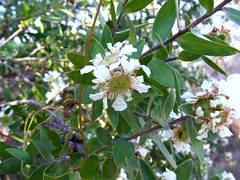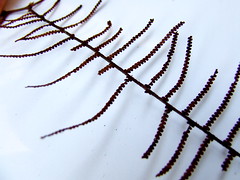In the ancient perched lake is a peaceful place not quite far enough from frolicking holidaymakers. We were thinking of glassy interpretations of this beautiful tea-tree stained lake with it's reedy edges, native fish and submerged melaleuca.
Wednesday, December 9, 2009
Wednesday, November 4, 2009
Brush Boxes
 Brush Box trees along the ridge of the old dune
Brush Box trees along the ridge of the old dune 
are now flowering

and shedding.
This tree grows all over the place in SE QLD once you start looking and takes different forms according to the conditions. Like melaleuca, stunted here, giant there. See what Tatters says about the size these trees can grow. Apparently brushbox blossoms make for quite uninspiring honey and the timbre contains silica that bluntens steel tools. Somehow that seems to increase their appeal.
Sunday, October 25, 2009
Stardbroke Island Sand Blow
At Stradbroke Rebecca took me on a deserted 4WD track. We walked through banksia forests and up a really steep track of soft ,soft sand to emerge at this....
A sand blow.
 It was like emerging into another world. The sun was setting, lighting up the beach spinifex and animal tracks.
It was like emerging into another world. The sun was setting, lighting up the beach spinifex and animal tracks.

Wind was blowing the beach spinifex around. Calligraphy in the sand.




A sand blow.
 It was like emerging into another world. The sun was setting, lighting up the beach spinifex and animal tracks.
It was like emerging into another world. The sun was setting, lighting up the beach spinifex and animal tracks.

Wind was blowing the beach spinifex around. Calligraphy in the sand.



Goenpul - People of the Pearl Shell

We spent the weekend at Stradbroke Island.
Words cannot encompass how beautiful and inspiring this was. We did a cultural/archeological/botanical tour with Shane Coghill of the Goenpul tribe- the People of the Pearl Shell. Shane took us right into the wallum on the narrow tracks made by wallabies. All around us was the stiff tangle of leucopogon, leptospernums, sedges and Dianella. As we looked into the heart of a clump of reeds for lizard eggs I noticed a Forked Sundew on it's long spindly stalk reaching through the blades towards the sun.
 Shane took us along an old road shaded by the huge Bloodwood trees, there was an eagles nest , big enough to house human children balanced high up.
Shane took us along an old road shaded by the huge Bloodwood trees, there was an eagles nest , big enough to house human children balanced high up. We took a lot of impressions in clay and our weird resin products. We took a lot of impressions in our impressionable brains, ancient stories, vegetation, dried leaves stippled shadows , in that strange, filtering, creative, process.
We took a lot of impressions in clay and our weird resin products. We took a lot of impressions in our impressionable brains, ancient stories, vegetation, dried leaves stippled shadows , in that strange, filtering, creative, process.
Labels:
ceramicist,
clay,
impressions,
jeweller,
resin,
stradbroke island,
sunset,
wallum
Sunday, October 18, 2009
Midyim
The midyim in the garden are flowering and I made a graphic background for our stall at Finders Keepers Market in a couple of weeks. I expect we will see lots of this edible berry growing on our trip to North Stradbroke Island later this week as it loves having its feet in sandy open forests where it forms a spreading understorey favoured by snakes. Pity it is the wrong time of year for the delicious gingery berries.

Sunday, October 4, 2009
crumunda park, wallum, September
Leptospernum flowering in Currimundi Lake (Kathleen McArthur) Conservation Park.
We did a workshop with Phoebe Hart from Hartflicker Films on filming with a small handheld camera. She gave us heaps of tips on using tripods, getting shots and getting footage suitable for editing into a finished product. The film will be part of the final exhibition as well as broadcast on the web. We hope to capture the collaboration from these early stages right though to finished exhibition work with accompanying footage of the making process in both studios.
We did a workshop with Phoebe Hart from Hartflicker Films on filming with a small handheld camera. She gave us heaps of tips on using tripods, getting shots and getting footage suitable for editing into a finished product. The film will be part of the final exhibition as well as broadcast on the web. We hope to capture the collaboration from these early stages right though to finished exhibition work with accompanying footage of the making process in both studios.
Labels:
ceramicist,
crumunda park,
film,
jeweller,
photography,
wallum
Thursday, October 1, 2009
Crumunda Park and the ground orchid
 Last week Rebecca and I both headed from our homes with cars full of friends/supporters and children to the lovely wallum of Crumunda Park at Currimundi Lake (Kathleen McArthur) Conservation Park. Arriving late, in various degrees of disarray we were met by Suzanne Aspland a local authority on the wallum. It seemed as if Suzanne was familiar with every tiny plant along the path as we walked through the ti-tree and paperbark forest and entered the golden, late afternoon light of the wallum heath.
Last week Rebecca and I both headed from our homes with cars full of friends/supporters and children to the lovely wallum of Crumunda Park at Currimundi Lake (Kathleen McArthur) Conservation Park. Arriving late, in various degrees of disarray we were met by Suzanne Aspland a local authority on the wallum. It seemed as if Suzanne was familiar with every tiny plant along the path as we walked through the ti-tree and paperbark forest and entered the golden, late afternoon light of the wallum heath.
Once again the need to really LOOK was impressed upon me as Suzanne pointed out the fine hairs in the throats of the tiny, white Leucopogon leptospermoides
The banksia normally known for it's knobbly brown seed pods used by May Gibbs as inspiration for the villains of "Snugglepot and Cuddlepie" had on a pale green coat knitted out of moss stitch. Velvety brown seed pods peeked out through slashes in this startling garment.
 Just as the sun went down we saw this beautiful ground orchid at the side of the path. Hidden under the trees this weirdly spotted delicate plant was the highlight of the day.
Just as the sun went down we saw this beautiful ground orchid at the side of the path. Hidden under the trees this weirdly spotted delicate plant was the highlight of the day.
Labels:
banksia,
ceramicist,
crumunda park,
jeweller,
leucopogon,
orchid,
wallum
Sunday, September 27, 2009
Pru Morrison Mold-making Workshop
 Last week we did a mold-making workshop with Pru Morrison at her fabulous Metro Arts Studio shared between about 5 other potters. How wonderful to work in this space- and share equipment and ideas with such an interesting group. We spent the first hour or so perving on works in progress and talking to Pru about her latest pieces bound for the big smoke.
Last week we did a mold-making workshop with Pru Morrison at her fabulous Metro Arts Studio shared between about 5 other potters. How wonderful to work in this space- and share equipment and ideas with such an interesting group. We spent the first hour or so perving on works in progress and talking to Pru about her latest pieces bound for the big smoke. Pru is an expert slip caster known for her slipcast simulacra of flasks, thermoses, bottles with legs and arms which she covers in naughty and thought-provoking terra sigilata drawings.
Pru is an expert slip caster known for her slipcast simulacra of flasks, thermoses, bottles with legs and arms which she covers in naughty and thought-provoking terra sigilata drawings. We wanted to learn the technique of making a plaster mold from an original form into which slip could later be poured. Shannon found a stick outside for that purpose. As we are casting from nature and Pru uses manufactured objects to create moulds, it was interesting for Pru as well as us as she figured out how to mold the stick. Pru's method was meticulous and patient. She was able to anticipate undercut problems and prevent them from occurring by leaving no dramatic corners and plugging up with clay.  The cast object could later be carved back if necessary. The piece was done in halves- as a 2-part mold. Some of Pru's more complex shapes are 6 or 8 parts and it can take a number of days to create a mold that will register and release well.
The cast object could later be carved back if necessary. The piece was done in halves- as a 2-part mold. Some of Pru's more complex shapes are 6 or 8 parts and it can take a number of days to create a mold that will register and release well.
 The cast object could later be carved back if necessary. The piece was done in halves- as a 2-part mold. Some of Pru's more complex shapes are 6 or 8 parts and it can take a number of days to create a mold that will register and release well.
The cast object could later be carved back if necessary. The piece was done in halves- as a 2-part mold. Some of Pru's more complex shapes are 6 or 8 parts and it can take a number of days to create a mold that will register and release well.Mixing and pouring the plaster was carefully done to minimise bubbles and while we were waiting we started to mold a cup handle from a 1950's cup. Before we knew it, it was 5 o'clock and we'd forgotten all about lunch!

The stick casting came apart perfectly and Pru said the mold was probably overengineered for the object but better to err on the safe side. I'm not sure that Shannon entirely agreed as she lugged the dinosaur-bone-like object back home on public transport!
We were both stuck by the contrast between Pru's crazy tattoo-like excisions on pots and her calm measured studio processes. But then you dont see many tattoo artists waving their arms around and emoting!
Friday, September 18, 2009
Sunday, September 13, 2009
Pouched Coral Fern
Making art from a collaboration is a bit like turning lead to gold. It's a mysterious process that requires a lot of faith and messing about with odd combinations and sticky stuff. We have started by visiting places together and collecting what I scientifically like to call "data". This means photos, drawings and impressions of the wallum. The impressions are literal, we have this strange putty-ish pink resin used for making dolls heads. You can pinch off a bit of this and soften it up in your hands then press it into leaves, rocks and bark. We came back from Poverty Point with a lot of impressions which I then cooked in the oven for about half and hour. One of my favourite forms of flora has been the Pouched Coral Fern . This amazing little fern contains it's spore in the myriad pouches along the stem.
The next time we go out I'll bring some porcelain. If the impressions pick up any organic matter it will burn out in the firing. As a ceramicist I've been looking at the initial impressions which is a negative of the form we cast. Rebecca uses a lot of impressions of the impressions creating a positive of the cast form.
Taking things out of context can reveal the abstract qualities such a line pattern and shape that are hard to discern in the complex quiet/noisy bush.
The next time we go out I'll bring some porcelain. If the impressions pick up any organic matter it will burn out in the firing. As a ceramicist I've been looking at the initial impressions which is a negative of the form we cast. Rebecca uses a lot of impressions of the impressions creating a positive of the cast form.
Taking things out of context can reveal the abstract qualities such a line pattern and shape that are hard to discern in the complex quiet/noisy bush.
Labels:
fern,
jeweller,
poverty point,
rainbow beach,
wallum ceramicist
Tuesday, September 1, 2009
Tin Can Melalueca
welcome to the wallum

The Wallum (Coastal lowland heath) areas of South-East Queensland are endangered but beautiful ecosystems often overlooked and threatened by encroaching pine plantations and residential ‘sea-change’ development. The humility of the low lying and stunted vegetation springing tenaciously from acidic soil is deceptive for like jewellery and small objects, huge variation (biodiversity) and intimate detail can exist on closer examination. The small but exquisitely jewel-like flowering and fruiting bodies, leaf types and stems provide forms to examine and draw out the metaphors and meanings of this rich ecotype.

Subscribe to:
Posts (Atom)





